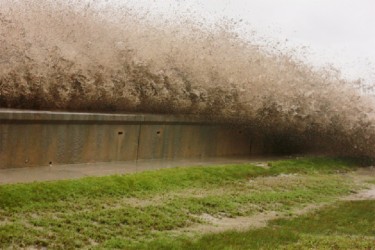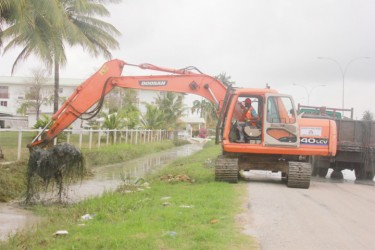Residents of several coastal communities yesterday woke to find their yards and homes under several inches of muddy seawater after windy conditions in the Atlantic propelled 1.5 meter swells, riding on 3.11 meter tides, over the sea defences.
Commenting on what may have led to the unexpected levels of overtopping, Minister of Works Robeson Benn explained that a “disturbance” in the Atlantic Ocean generated strong waves which rode on top of the regular tide which came parallel to the top of the walls. It was these “swellings,” he said, which came over the seawall and caused the level of flooding seen.
In addition, he said, the clogged drains in areas adjacent to the Rupert Craig Highway prevented the water from reaching the Liliendaal pump which had the capacity to take it off.

Benn, yesterday identified West Coast of Demerara villages including Dem Amstel and Leonora as having been affected by the flooding, while areas between Liliendaal and Vlissingen Road along the Rupert Craig Highway, were also under water.
Stabroek News also understands that the West Coast village of Uitvlugt, as well as several coastal communities along the Essequibo River were under water up to midday yesterday.
Benn said that the Rupert Craig Highway, in the vicinity of the Russian Embassy had been made completely impassable by large deposits of shells brought over the seawall by the high waves. When Stabroek News visited the site a team from the Demerara Harbour Bridge Corporation (DHBC) was working to remove the shells from the road and the drain running along the seawall. DHBC General Manager Rawlston Adams, who was overseeing the work, said that they were asked by the Works Ministry to assist in the removal of the shells so as to make the highway accessible as soon as possible.
Benn explained though, that the area would remain closed to public transportation since 2.9 meter tides were expected in the afternoon, and the ministry was not sure if there would be a recurrence of the morning’s phenomenon. “We want to be on the lookout this afternoon so we have closed off the section of the road from Vlissingen Road to Sheriff Street,” Benn said. The area however was not closed off to curious pedestrians who flocked to the seawall during the high tide yesterday afternoon seeking a replay of the morning’s display.
A Subryanville resident yesterday said that the water which flooded his area rose in about thirty minutes. The man said that in no time the floodwaters filled and overtopped the drains which were mostly empty prior to the flooding. The resident, who lives in Fourth Street Subryanville, said that though the flooding caused by the spring tides which occurred on March 12 were bad, this was definitely worse since the water did not get as far as Fourth Street then.
The resident also said that he never saw floodwaters in his area retreat so fast.
The Ocean View International Hotel was once again affected by the floodwater, although its proprietor, Jacob Rambarran, said this instance was a far cry from what occurred in March when the establishment lost millions.
In March Rambarran had told Stabroek News that as much as three feet of water got into the hotel causing severe damage. He said that water also got into several of the hotel’s rooms, several of which were occupied. The man had said that he was forced to refund several of his customers, but that he was better prepared this time.
 He said that he has since elevated generators and other important equipment, and erected barriers around exits and entrances at the back of the hotel. These precautions, he said, kept him from sustaining any substantial damage this time around. He said, however, that water did get into the hotel through valves in the barriers which were left open, and through the front door which his employees had a hard time closing once they realised the water was coming.
He said that he has since elevated generators and other important equipment, and erected barriers around exits and entrances at the back of the hotel. These precautions, he said, kept him from sustaining any substantial damage this time around. He said, however, that water did get into the hotel through valves in the barriers which were left open, and through the front door which his employees had a hard time closing once they realised the water was coming.
The proprietor said that the water overtopped the seawall, came down the highway and entered the yard and the hotel, primarily through the front door.
Members of the Guyana Fire Service were seen yesterday morning hosing the road in the vicinity of the hotel to remove a particularly thick deposit of mud and sediment.
Benn said that prolonged flooding in areas along the Rupert Craig Highway was caused by clogged drains which prevented the water from reaching the pump at Liliendaal. He said that the pump was more than capable of “taking off the water,” but that the clogged secondary and tertiary drains were preventing this from occurring. The drains were blocked with shells and garbage which were brought over with the tide.
The Minister said that there are conduits going across the road to “take the water off.” He said that the water is then supposed to go through the secondary drainage into the canal which takes it to the pump station at Liliendaal.
It was the blockage of the conduits with garbage and shells combined with poor secondary and tertiary drainage in the area which prevented the water from getting to the pump, he said, and this led to the flood.
He said that other than the primary reason that water came over the seawall, the real factor which led to the flooding was the clogged drainage system.
“If you go and see the canal still has capacity at the pump station, but the water hasn’t gotten to it. The water is not getting to the canal pump station quickly enough,” said Benn. When asked why more effort was not invested in clearing the secondary and tertiary drainage systems in the area Benn said that the responsibility rested with the Georgetown City Council.
Benn said that another reason for the overtopping was that the erosional front, marked by the shell bank in the vicinity of the Russian Embassy, which is low in the foreshore, allows water to come closer to the wall. “Everywhere the shell bank is moving along we’re having this phenomena. We had it three or four years ago at Better Hope and a couple times last year it happened between Ogle and Turkeyen. Now it is here moving along.”
Benn also said that the weekly lime held at the seawall kills the grass which leaves the dirt bare and susceptible to erosion by rain or the high tides. He said that this dirt flows into the drains and blocks them. In addition, garbage wantonly discarded by seawall patrons, he continued, also finds its way into the drains which adds to the blockage.
“All of that is impeding the flow of water from getting to the pumping stations immediately, and so it all piles up and overwhelms,” the Minister said. In light of this issue Benn said, “We intend to work with the police and others to probably shift the activities to another location.





